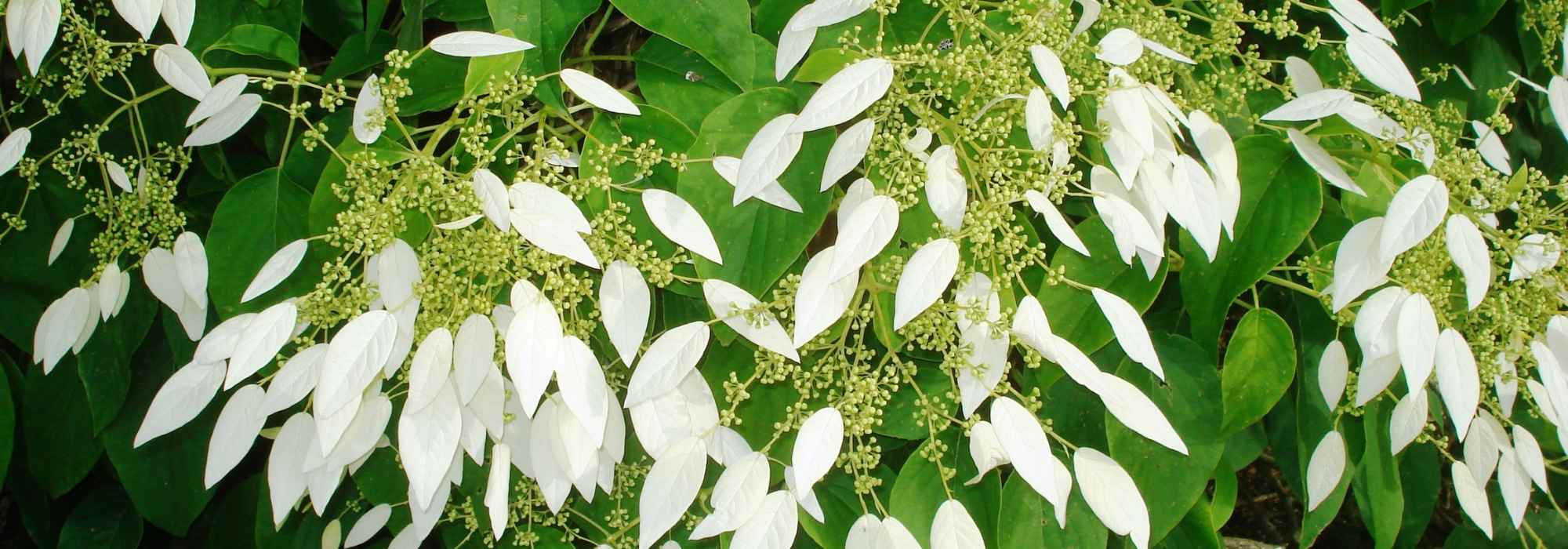
Schizophragma hydrangeoides: planting, cultivation, maintenance
Contents
Schizophragma in a nutshell
- Schizophragma is a climbing plant with a beautiful summer flowering, forming large inflorescences up to 30 cm in diameter.
- Known as ‘false climbing hydrangea’ or ‘Japanese climbing hydrangea’, it clings to supports without causing damage.
- Its dense foliage is deciduous and takes on beautiful colours in autumn.
- It favours semi-shaded positions and cool, humus-bearing soils with a tendency to acidity.
- Rather hardy, Schizophragma is ideal for dressing the trunk of a large tree, a wall or a pergola.
- Its flowering, enhanced by white or pink bracts, is more spectacular and refined than that of its close relative, Hydrangea petiolaris, with which it is often confused.
- A little slow to establish, this still little-known liana with woody climbing stems requires little maintenance for a spectacular decorative effect.
A word from our expert
Schizophragma is a very beautiful climbing plant valued for its spectacular summer flowering. More than its small flowers, it is the large bracts surrounding them that steal the show. They can be ivory-white as in the species, Schizophragma hydrangeoides, or tinged with pink in Schizophragma ‘Rose Sensation’. Together they form airy inflorescences 20 to 30 cm in diameter.
Fairly close and often mistaken for Hydrangea petiolaris, this ‘false climbing hydrangea’ offers a more spectacular flowering that can last up to three weeks.
Foliage is opposite, deciduous to semi-evergreen, heart-shaped, sometimes dentate and pubescent. Leaves are borne on robust, sinuous stems. Most species have green leaves, but Schizophragma ‘Moonlight’ has velvety leaves with silvery reflections and well-marked veins. Schizophragma ‘Angel Wings’, meanwhile, bears large rough grey-green leaves highlighted by darker veins.
Japanese climbing hydrangea is a rooting liana, equipped with powerful climbing roots that allow it to attach itself unaided to supports without damaging them. It is therefore ideal for climbing a tree, dressing a cool wall or festooning a pergola.
Fairly hardy, Schizophragmas tolerate down to -10°C, some even lower.
Climber for light shade, Schizophragma prefers positions not exposed to burning sun though a little sun, for example late afternoon, encourages good flowering.
Growing in neutral to acidic soil, it needs a fairly rich, humus-bearing substrate that retains freshness while being well drained.
Description and botany
Botanical data
- Latin name Schizophragma sp.
- Family Hydrangeaceae
- Common name False climbing hydrangea, Japanese climbing hydrangea
- Flowering Summer
- Height 3 to 10 m
- Sun exposure Partial shade, light shade, non-scorching sun
- Soil type fresh, humus-bearing, well-drained, acidic to neutral
- Hardiness -10°C to -20°C
The Schizophragma originates in wooded, humid regions of Asia (Japan, Himalaya, Taiwan). Belonging to family Hydrangeaceae, like Deutzias or mock-oranges, its closest relative is Hydrangea petiolaris, another climbing hydrangea to which it bears resemblance. It differs, however, by a more spectacular flowering in large inflorescences with very decorative bracts. Introduced to Europe in the late 19th century and awarded by the Royal Horticultural Society for its beauty, it remains a fairly unknown and little-used plant.
Schizophragma, also called ‘Japanese climbing hydrangea’ or ‘False climbing hydrangea’, is a woody climbing plant. It is a rooting liana with twisted branches that attach themselves to supports thanks to aerial roots but, unlike ivy, its climbing roots do not damage structures. Slow-growing, this climbing hydrangea needs 2 to 3 years to settle properly and requires training in its early stages.
There are 4 or 5 species commonly grown in gardens. Some do not exceed 4 metres in height, such as Schizophragma ‘Moonlight’ or Schizophragma corylifolium. Others are more vigorous and require suitable supports. This is the case for Schizophragma fauriei, the giant of the genus, which can reach nearly 15 m. Spread rarely exceeds 3 to 4 m.
False climbing hydrangea produces main branches that grow vertically. Along these framework branches are produced lateral branches that bear the inflorescences. Between May and August, for almost three weeks, many small flowers appear at branch tips, in flattened cymes. Fertile and melliferous, they are much appreciated by pollinating insects. This climber is first noticed for its large bracts surrounding the flowers. Carried on long petioles, elongated and pointed in shape, they seem to float around the plant. In the wind, these ‘teardrops’ give the impression of a cloud of butterflies having taken over the scene. The inflorescences then dry and remain decorative until winter.
Mostly ivory white, the bracts take on a delicate pink in a single variety, Schizophragma ‘Rose Sensation’, sometimes sold under the name ‘Roseum’.

Inflorescences of False hydrangeas: Schizophragma hydrangeoides, S. hydrangeoides ‘Rose Sensation’ and S. integrifolia
Schizophragma integrifolia is perhaps the most spectacular with its white inflorescences, larger (up to 30 cm) and more graceful.
Slow to establish, Schizophragmas may not flower during the first 2 or 3 years but once established they become increasingly attractive year after year.
With dense growth, Schizophragma displays opposite, heart-shaped leaves. Sometimes pubescent with slightly dentate edges.
Foliage is deciduous to semi-evergreen and ranges from pale to deep green, except in Schizophragma ‘Moonlight’ which shows silvery reflections that highlight darker veins. Leaves also take attractive autumn colours, turning a deep red.
Schizophragma ‘Angel Wings’ also stands out for grey-toned foliage.
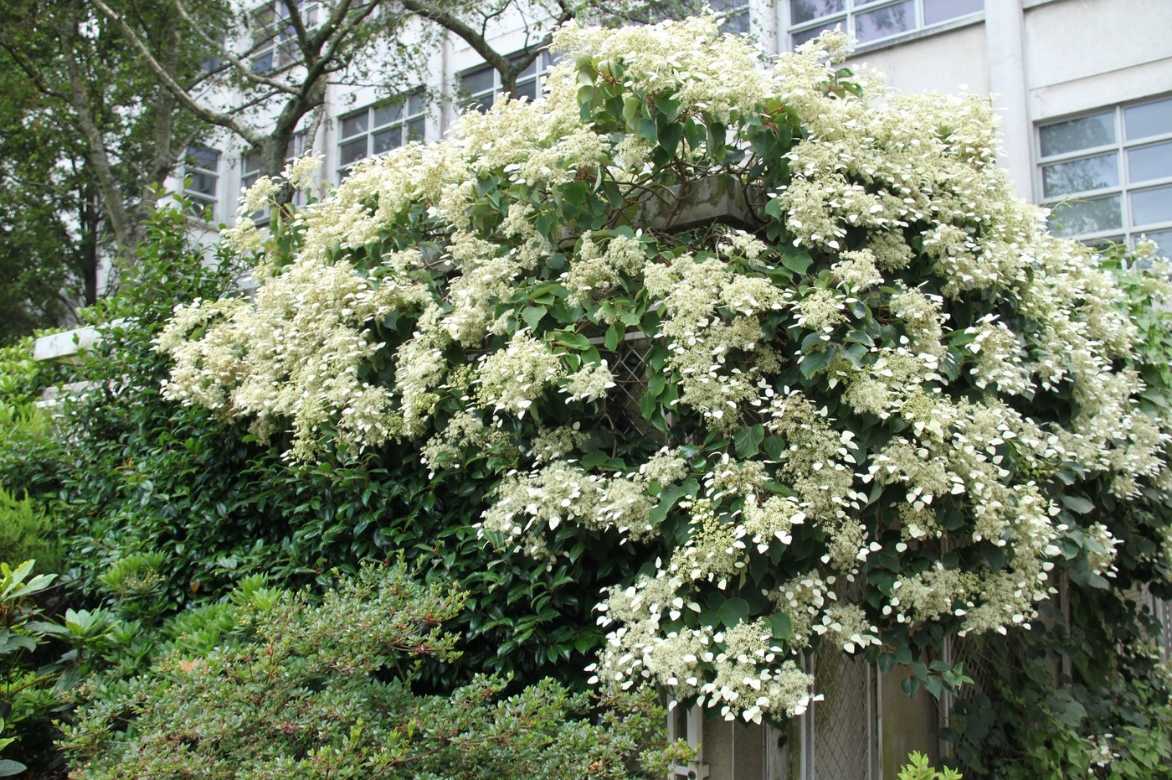
All Schizophragmas prefer fairly fertile soils, rich in humus, fresh but well-drained. They tolerate neutral soils but show a preference for slightly acidic conditions. They can grow in heavier, clay soils provided water does not stagnate in the bad season.
A woodland liana, flowering of false climbing hydrangea is best in partial shade or light shade. It tolerates denser shade but will be less showy. Sunny positions are possible provided sun is not scorching (avoid south-facing walls) and soil remains cool.
Schizophragma is very resistant to disease but young shoots can attract slugs and snails. Natural control methods exist, and this risk mainly concerns young plants. Aphids may also appear but rarely pose a threat. In case of significant infestation, find out how to limit their presence.
Different varieties of Schizophragmas
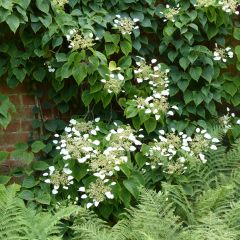
Schizophragma hydrangeoides
- Flowering time July to September
- Height at maturity 10 m
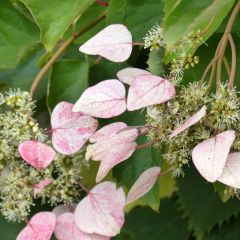
Schizophragma hydrangeoides Rose Sensation
- Flowering time July, August
- Height at maturity 6 m
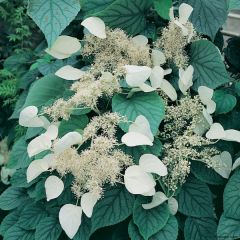
Schizophragma hydrangeoïdes Moonlight
- Flowering time July, August
- Height at maturity 4 m
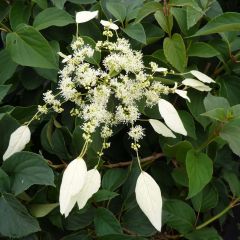
Schizophragma hydrangeoides Windmills
- Flowering time July to September
- Height at maturity 5 m
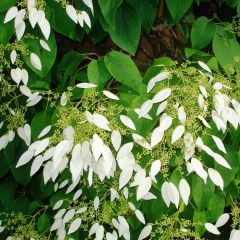
Schizophragma integrifolium
- Flowering time July to September
- Height at maturity 8 m
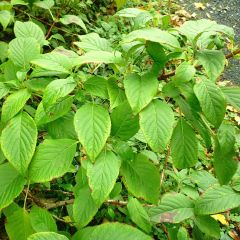
Schizophragma corylifolium
- Flowering time June to August
- Height at maturity 4 m
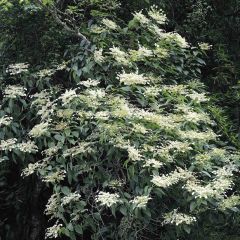
Schizophragma fauriei
- Flowering time August, September
- Height at maturity 15 m

Schizophragma fauriei Angel Wings
- Flowering time August, September
- Height at maturity 15 m
Discover other Schizophragma
View all →Available in 0 sizes
Available in 1 sizes
Available in 1 sizes
Available in 2 sizes
Available in 1 sizes
Available in 1 sizes
Available in 1 sizes
Available in 1 sizes
Available in 2 sizes
Available in 1 sizes
Where, when and how to plant Schizophragmas?
Where to plant?
Schizophragmas prefer bright, semi-shaded positions where light promotes flowering. In regions cooler north of the Loire, planting in sun is possible. Further south, a north-facing aspect is an option.
Plant your ‘False climbing hydrangea’ in rich, deep, humus-bearing soil. It prefers acid-leaning soils but accepts neutral soil. If needed, add heather soil or turf, and compost, to which add some crushed horn. In all cases, avoid calcareous soils.
Although it can tolerate occasional drought once established, prefer a soil that remains cool but not waterlogged, especially in winter.
‘Japanese climbing hydrangea’ is a liana. It needs a support to cling to. Install it on the trunk of a deciduous tree or where shade is not too dense, train it up a wall, let it festoon a pergola of suitable dimensions or cloak a garden shed with its delicate flowering.
On a terrace or large balcony, plant your Schizophragma in a pot of generous size (minimum 50 cm in each direction) and use it to screen a wall or to climb a trellis.
In any case, Schizophragma is slow to establish. Expect 2 to 3 years before it really gets going (and flowers). To help it, and before it can cling by itself, guide and stake its branches.
Once well established, growth speeds up and flowering becomes more generous each year.
When to plant?
Plant Schizophragma ideally in autumn, when soil is still warm and seasonal rains ensure necessary moisture. Spring planting is also possible; in that case, water regularly if conditions are dry.
How to plant?
Planting in the ground :
1. Begin by soaking the rootball in plenty of water so the whole substrate becomes evenly moist.
2. Ideally, dig a hole 2 to 3 times the width of the rootball and about 50 cm deep. Adapt planting distance to the chosen support:
– Plant at the base of a post if training Schizophragma up a pergola, for example.
– If the support is a tree, find a pocket of soil between two large roots, about 50 cm from the trunk. Dig carefully to avoid damaging large roots and cut small ones cleanly with a pruning shear. When positioning, set the plant at an angle, facing the trunk.
– Against a facade, an overhang may deprive the plant of all or part of the rainwater. In that case, move the planting hole to compensate for this (or check soil moisture regularly!).
3. Lay a bed of gravel about 5 cm thick in the bottom of the hole to ensure good drainage.
4. Place a stake if needed in the planting hole and angle it towards the support to help the liana cling. After 2 or 3 years it will manage on its own.
5. Mix the excavated soil with quality potting compost or heather soil, and a shovelful of well-rotted compost. Add a handful of crushed horn which will feed the plant in the long term.
6. Remove the plant from its pot and place the rootball in the hole, backfilling with the mixture.
7. Firm the soil lightly and form a basin to help water reach the roots.
8. Water generously so soil adheres well to the roots.
9. Secure the main branches to the stake using soft ties and without strangling the shoots.
10. Mulch the base using leaf litter, dried grass clippings, ramial chipped wood or commercial mulches (flax chips, buckwheat or coconut husks, pine bark…). A several-centimetre thickness ensures the soil stays cool at the plant’s base.
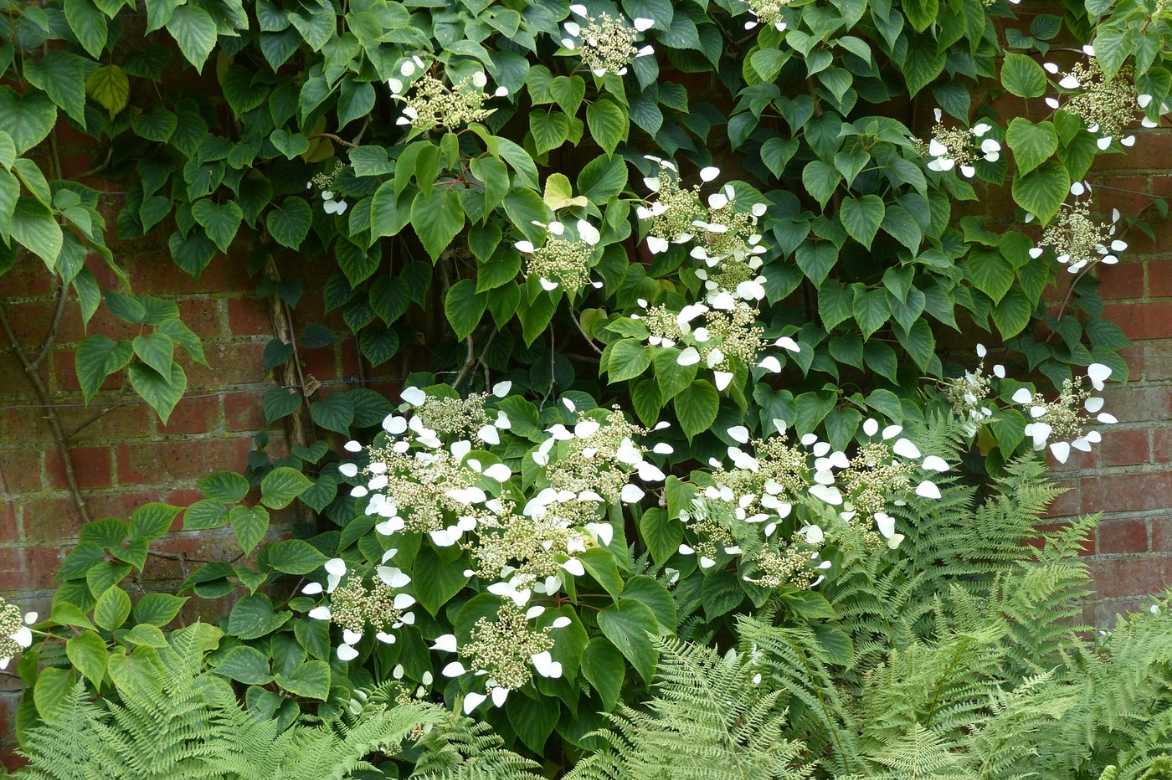
Planting in a pot :
As pot volume is naturally smaller than in-ground, growth is usually reduced. Container size therefore matters: the larger it is, the more nutrients and moisture the plant has. A pot 50 cm in each direction is a minimum for a climber such as Schizophragma. Ensure the pot has drainage holes so water does not stagnate. Fresh soil does not mean waterlogged!
1. Soak the rootball so it becomes fully saturated.
2. Mix heather soil (1/3) with rich potting compost (2/3). Turf, once dry, is very hard to rewet and Japanese climbing hydrangea needs a cool soil. Add a handful of crushed horn to feed the plant long-term.
3. Place a 5 cm layer of gravel in the bottom of the pot. Lay a geotextile over the gravel to prevent the soil from mixing with this drainage layer.
4. After optionally placing a stake in the pot (unnecessary if the plant will climb a trellis), place the rootball and backfill with the mix.
5. Firm lightly. Leave 2 to 3 cm between the substrate surface and the pot rim. This allows for easy mulching and watering.
6. Orient Schizophragma towards its support and fix the main branches (without strangling them) using soft ties.
7. Water little by little until water runs from the bottom of the pot.
8. Mulch to maintain freshness. Use organic mulches (bark, flax chips…) or mineral mulches (gravel, pebbles, slate chips…) depending on chosen style.
Using a saucer provides a water reserve for the plant in hot weather but it must be removed during winter so roots remain dry. However, the larger the pot, the heavier and harder it is to handle. You may also damage the plant (fixed to its support) when moving it. An alternative is to fill the saucer with clay balls before placing the pot on it. Even when the saucer is full of water, the roots stay dry, while evaporation creates a more humid, cooler atmosphere beneficial to the plant.
Caring for Schizophragmas
During the growing season, if rainfall is scarce, water regularly, especially in early years. Once established, Schizophragma can tolerate short periods of drought. Prefer a thorough watering once a week rather than small daily waterings, except in pots where substrate dries more quickly.
In winter, natural rainfall is generally sufficient. Intervene only if necessary and always outside periods of severe frost, especially if plant is potted.
Every spring, add compost and replace a good layer of mulch. Incorporate a handful of blood meal in late spring. This quick‑acting feed boosts flowering.
In pots, remove mulch in early spring, also add compost or a rich potting mix amended with horn meal and replace the mulch. From May to August, water monthly with a suitable feed (follow dosages on packaging) but never onto dry substrate.
Pruning of Schizophragma is not obligatory. It is in any case unnecessary in first years as growth is slow.
If necessary, work in late winter or early spring. Remove any dead wood and cut back misplaced or overly long stems as desired.
Schizophragmas are hardy plants. Only slugs and aphids may attack young foliage. Find out how to fight slugs naturally and how to identify and control aphids.
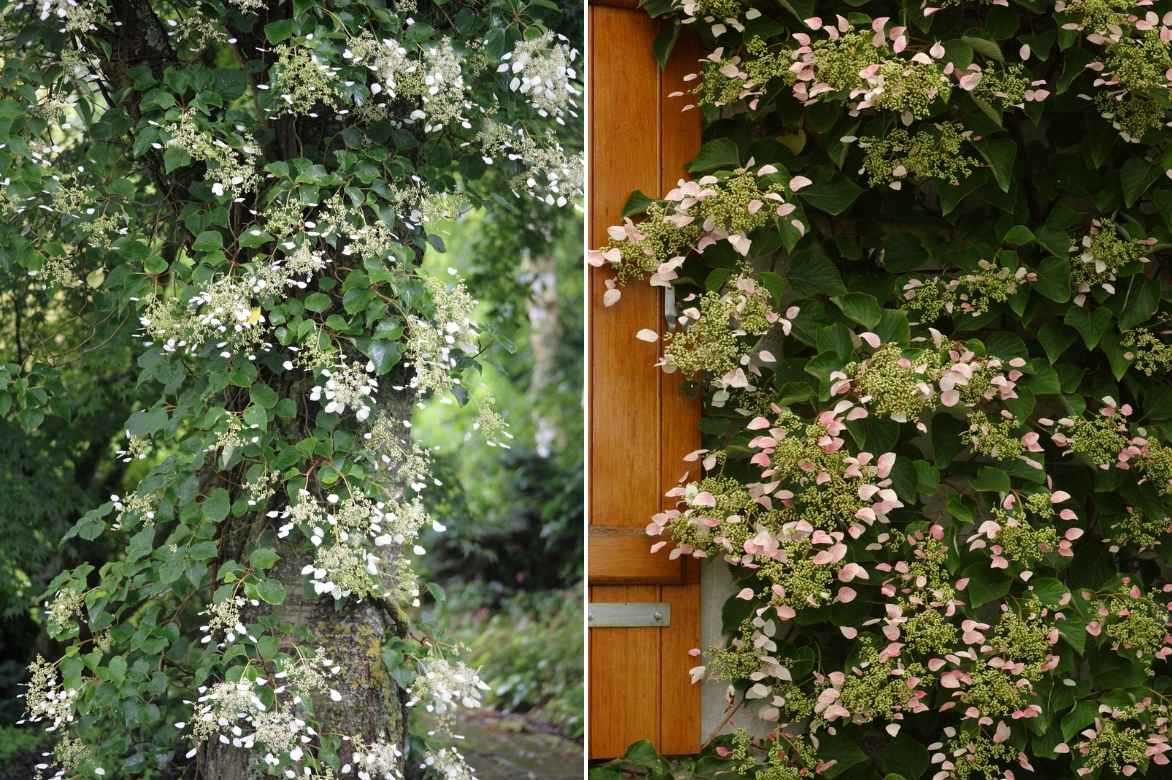
Propagating Schizophragmas
False climbing hydrangea is slow-growing, especially during first 2 to 3 years. If you want to propagate it, wait until it is well established.
Propagation can be achieved by propagation by cuttings in summer or by layering.
Propagation by cuttings of Schizophragma
Propagation by cuttings is carried out in summer (between July and September)
- In a pot, make a mix of equal parts light potting compost combined with sand or finely crushed bark. Mix should be free-draining but capable of retaining moisture.
- Choose a piece of semi-herbaceous stem (base slightly firmer and tip more tender) 6 to 10 cm long.
- Cut just below a node (swelling where a branch inserts) with a disinfected pruning shear.
- Prepare the cutting: remove any side shoots and leaves so only two remain at top of cutting. Cut remaining leaves in half to reduce evaporation.
- Using a knife or blade of your pruning shear, lightly wound base of cutting. Only remove a very superficial layer of tissue, about 1 centimetre, without reaching internal layers of stem. Optionally, you can dip base of your cutting in rooting plant hormone, sold in garden centres, often as a powder. Tap cutting to remove excess powder.
- Make a pilot hole in substrate using a pencil for example and insert cutting until leaves are level with substrate then water gently so as not to disturb cutting.
- Cover compost with a thin layer of gravel which helps keep surface cool and reduces evaporation.
- Cut top off a plastic water bottle and place it over the pot. Kept covered like this, cutting roots faster and more easily. Remember to remove it for a few minutes each day to aerate.
- Place cuttings outdoors in a bright spot out of direct sun and check regularly that compost remains moist but not waterlogged.
- Appearance of new leaves indicates successful rooting. Continue monitoring (watering if necessary, airing) and plant cutting in its final position in autumn of following year.
Layering of Schizophragma
Layering is a process that sometimes occurs naturally and that gardener can also induce. Part of plant in contact with soil will produce roots which then give rise to an independent specimen.
Layering can be done throughout year, but prefer March or autumn.
- Prepare soil a few centimetres from base of your Schizophragma. Turn soil over about 30 centimetres in all directions, remove stones and weeds. Add light, free-draining potting compost and mix well with original soil.
- Choose a stem less than 2 years old, growing near ground, flexible enough to be handled without breaking. It should be long enough to be laid on soil for at least 60 cm.
- Keep tip of stem intact for 15 to 20 cm. Remove leaves or branches from middle then, using a disinfected knife or blade of a pruning shear, make a slight incision in the bark for a few centimetres. Make incision on side of stem that will face soil.
- Make a small trench in prepared soil, lay stem in it so incised section is in contact with soil then cover with a few centimetres of soil.
- Secure layered stem using metal pegs or a sufficiently heavy stone.
- Gently raise tip of stem by tying it vertically to a stake planted in soil.
- Water and check regularly that substrate does not dry out.
- After one year, layer will have produced roots at incision. Time to sever it. Cut branch a few centimetres before new roots, gently lift your new young plant and place it in a pot to strengthen it further or plant directly in ground.
Pairing Schizophragmas in the garden
Climbing plant for light shade, Schizophragmas pair well with many trees with sparse foliage, for example an old fruit tree that flowers in spring and whose trunk becomes covered in flowers in summer.
In a bright position, pair the Schizophragmas with other flowering climbing plants such as an Akebia or a Clematis or with lianas whose foliage turns fiery in autumn such as Ampelopsis or Parthenocissus.
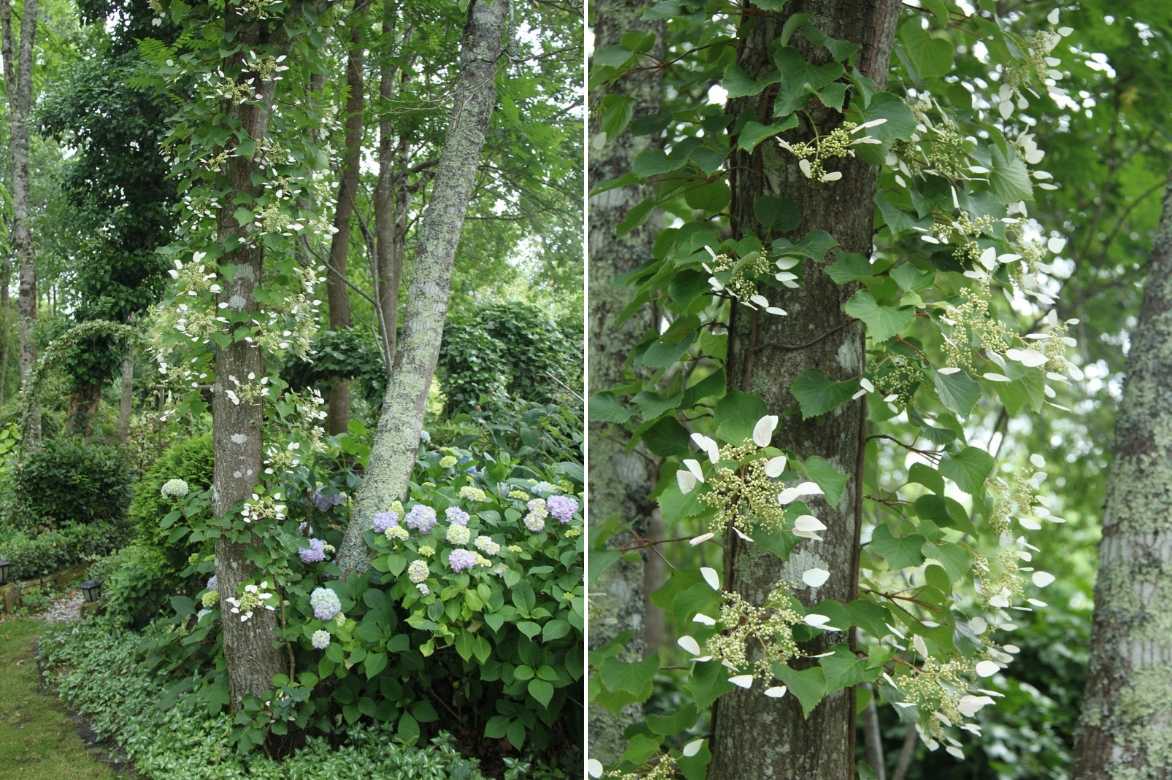
An example of an understorey combination: a Schizophragma hydrangeoides climbs a tree with at its base a Hydrangea macrophylla and a tapetum of lamiums as groundcover
Play on contrasts of shape and texture with foliage of ivies, some of which display very attractive variegation.
In mild climates, Berberidopsis flowers at the same time in clusters of red bell-shaped flowers.
Dress their base with hydrangeas whose inflorescences echo those of the climber. Hydrangea aspera ‘Hot Chocolate’ provides a striking contrast with its very dark foliage that turns golden in autumn.
Did you know?
The name Schizophragma comes from ancient Greek ‘schizo’ (“to split”) and ‘phragma’ (“screen, barrier”). The origin of its name simply refers to the shape of its fruiting structures. So don’t panic! This lovely liana will not split the wall on which it climbs. Unlike other climbing plants, such as ivy, Schizophragma never damages its support.
Useful resources
Discover our range of Schizophragmas!
Other charming climbing plants, hydrangeas.
Our selection of shade-loving climbing plants.
Frequently asked questions
-
Why won't my Schizophragma cling?
Schizophragma is slow to establish. For first two or three years it needs staking until it develops its climbing roots. After that it becomes self-supporting and clings unaided to its support.
-
Why doesn't my Schizophragma have flowers?
Slow-growing, Japanese climbing hydrangea may not start flowering until after two or three years. Be patient, it will then reward you with more beautiful flowering each year.
-
What is the difference between a Schizophragma and a climbing hydrangea?
Schizophragma and Hydrangea are climbing plants of the same family. Their needs and cultivation are similar. The difference is primarily botanical. While the small greenish-white flowers of Hydrangea petiolaris are surrounded by pseudo-flowers (sterile flowers) composed of 4 petaloids, Schizophragma displays larger solitary bracts that are elongated and teardrop-shaped, which makes the flowering more spectacular. Schizophragma's bracts also retain a neater appearance once dried and therefore remain decorative for longer.
- Subscribe!
- Contents
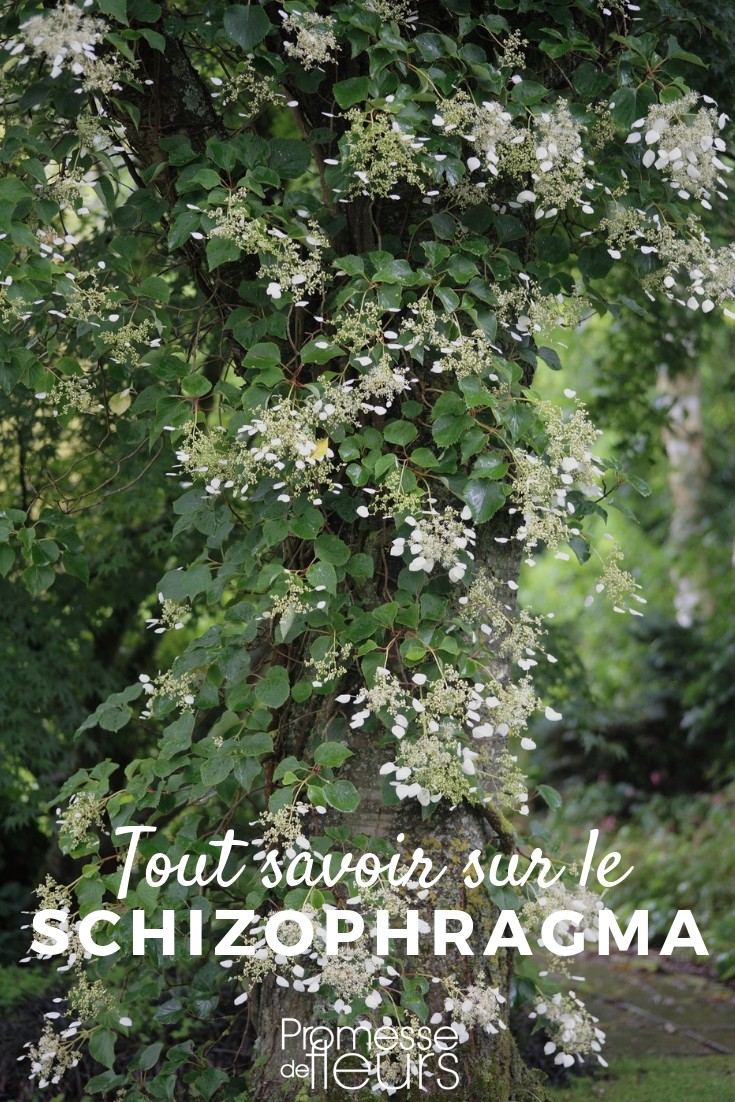































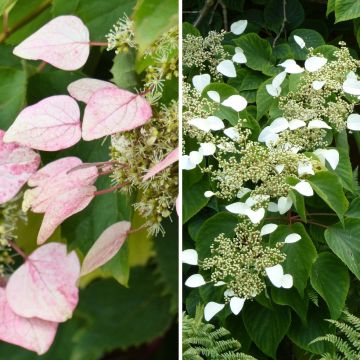



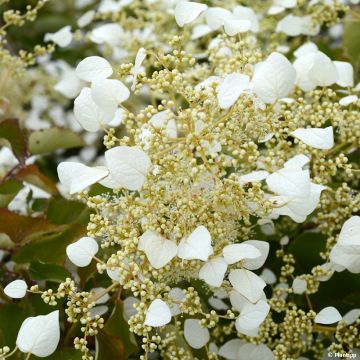


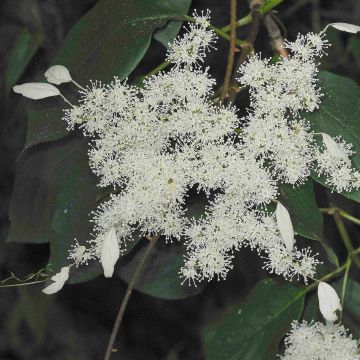


Comments